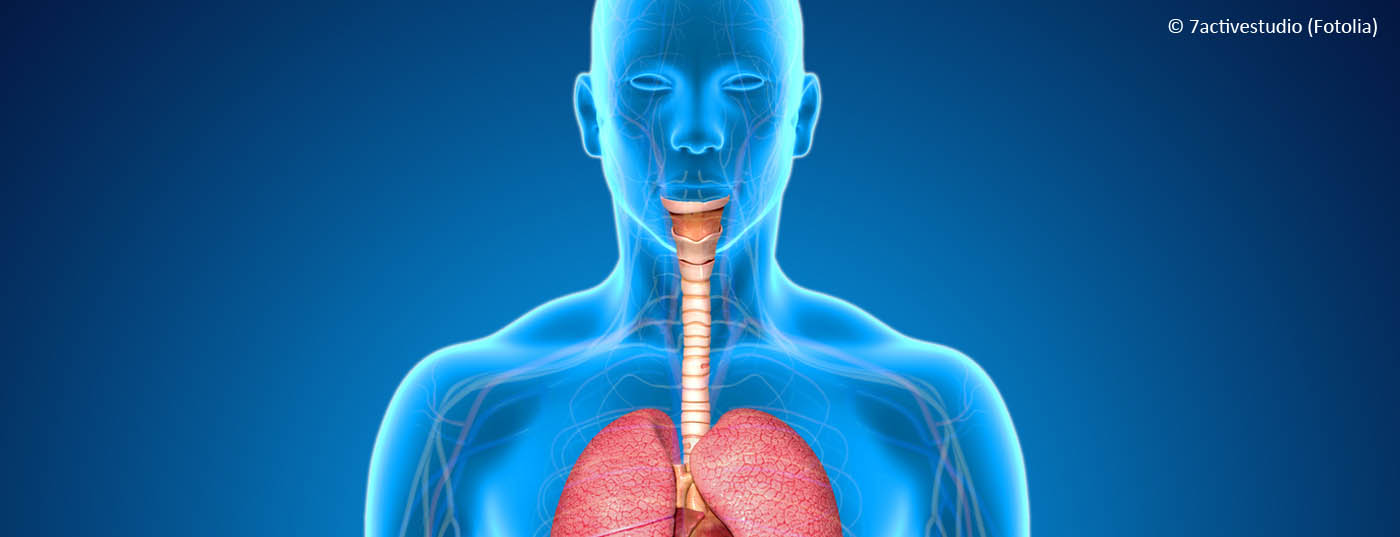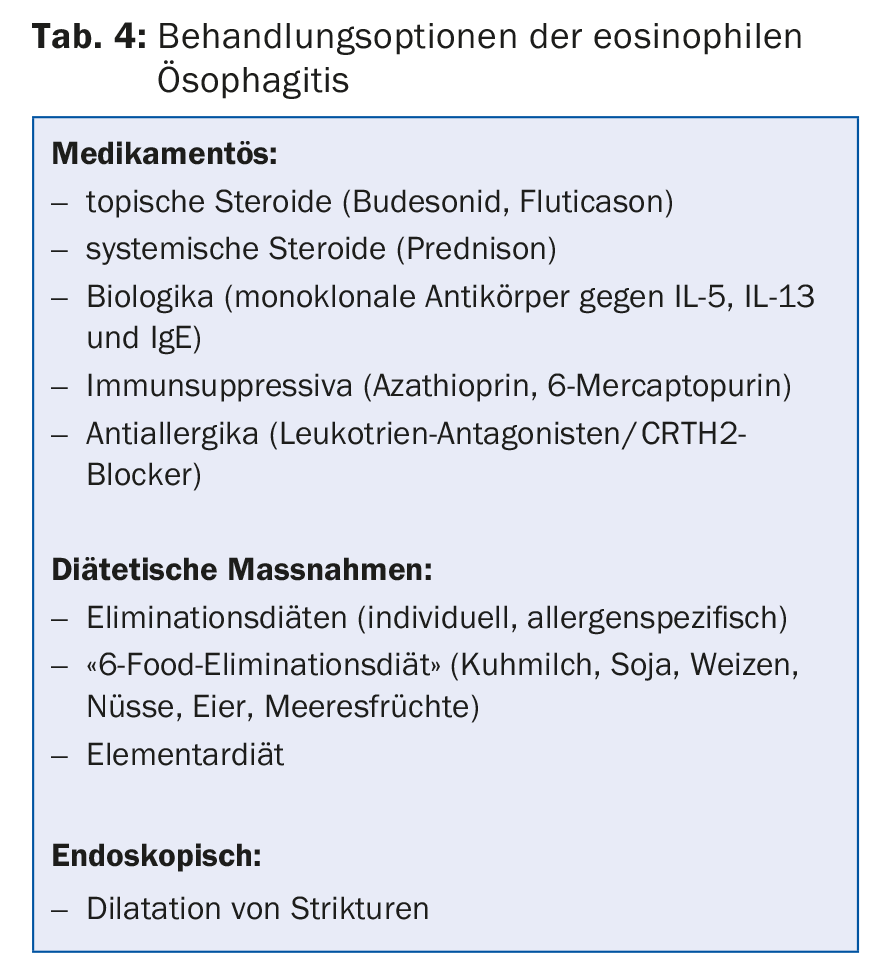Dysphagia and bolus impaction are highly suspicious for the presence of eosinophilic esophagitis in younger patients. To confirm the diagnosis, biopsies are taken from different segments of the esophagus during gastroscopy. Topical corticosteroids are the first-line therapy for drug treatment of EoE. Anti-inflammatory treatment is intended to prevent fibrosis of the esophagus.
Eosinophilic esophagitis (EoE) is defined as an inflammatory, immune-mediated esophageal disease. Clinically, it is characterized by a combination of esophageal discomfort and histologically by infiltration of the esophageal mucosa with eosinophilic granulocytes [1,2].
The messenger interleukin-5 (IL-5) is one of the central factors, primarily in the differentiation and later in the recruitment of eosinophil granulocytes. In patients with EoE, the esophageal mucosa is infiltrated with IL-5-expressing cells, and the esophageal squamous cells massively express the important inflammatory mediator TNFα. In addition to the eosinophilic granulocytes, in EoE more specialized T cells are found in the esophageal mucosa as well as mast cells, which produce mediators of a so-called Th2-type reaction and play an important role in allergic diseases. However, whether the initial trigger is a reaction to an inhaled or peroral allergen or a combination of different allergens remains unclear.
Differential diagnosis
Esophageal eosinophilia is nonspecific and is also observed in other, non-allergic diseases (Tab. 1) . Differential diagnosis should take into account the very common reflux disease, in which eosinophilic infiltration can occur especially in the distal esophageal segment. Less commonly, more severe eosinophilic infiltrations, which may mimic the picture of primary EoE clinically and histologically, are found in the setting of roundworm infections (e.g., Anisakis simplex and Toxocara canis). If suspected – e.g. in patients from maritime or tropical regions as well as in lovers of raw fish food – these tissue-invasive helminthoses should be searched for by serology.
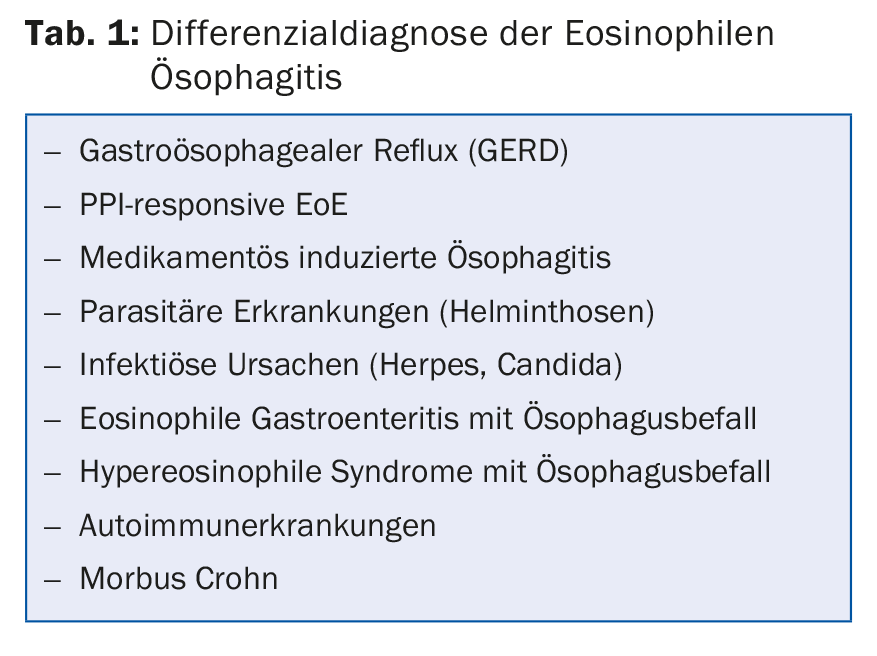
Leading clinical symptoms
Clinical symptoms may present differently depending on patient age (tab. 2) . The most common presenting symptom in adult patients is dysphagia for formed food, which can range from mild gagging on passage to complete obstruction. More than 50% of EoE patients have already suffered impaction at the time of diagnosis [3]. Careful attention should be paid to evasive strategies when taking the history. To ensure the most unobstructed food passage possible, an EoE patient eats slowly, chews carefully, and drinks plenty of fluids between food boluses. The two symptoms of dysphagia and/or bolus impaction are therefore highly suspicious for the presence of EoE in younger patients. Retrosternal pain may occur in 20-50% of patients. Unlike heartburn, these are not described as rising in reflux disease and also usually do not respond to acid blockers. In children and adolescents with EoE, a much broader spectrum of complaints can be observed, depending on age (Table 2). Physical examination is practically always unproductive in adults and children.
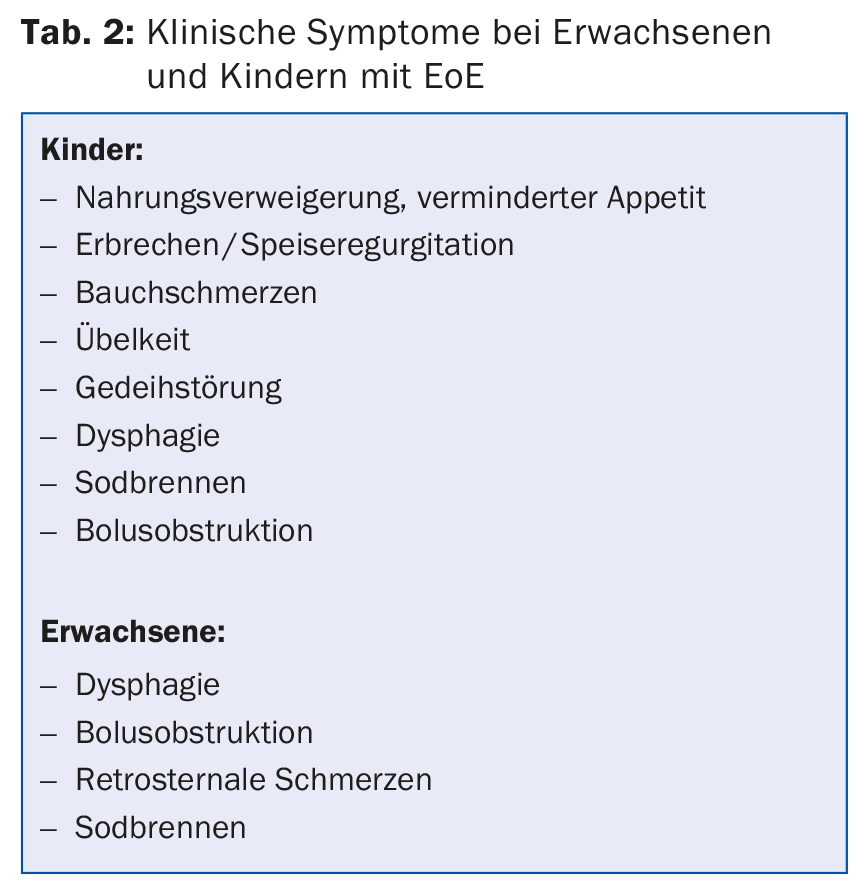
Endoscopic findings
There is no established disease-specific biomarker in the diagnosis of EoE. Gastroscopy with biopsy of the esophagus is thus the most important diagnostic step in the workup of a patient with dysphagia and thus suspected EoE (Table 3).
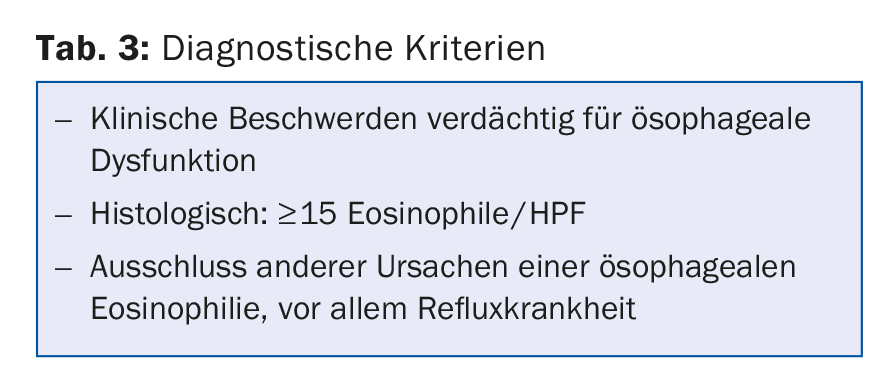
In about half of the EoE patients examined, endoscopic findings are only discrete and easily missed. The esophagus may also present inconspicuously. The following endoscopic findings are the most common and are recorded in a newly developed classification system [4]: When inflammation is active, inconspicuous reddish longitudinal furrows (red furrows, Fig. 1a) and white, sometimes pinhead-like, deposits (white exudates, Fig. 1b) can be observed. They correspond histologically to dense infiltrates of eosinophilic granulocytes, the so-called eosinophilic microabscesses. These are specifically biopsied. Other endoscopic signs include solitary rings, but also multiple rings that can give the esophagus a trachea-like appearance (Fig. 1c), or the so-called crepe paper mucosa. Typically, multiple endoscopic signs may be present in combination (Fig. 1d). Even with an inconspicuous aspect, it is important to obtain biopsies from different segments of the esophagus to obtain the histology needed for diagnosis.
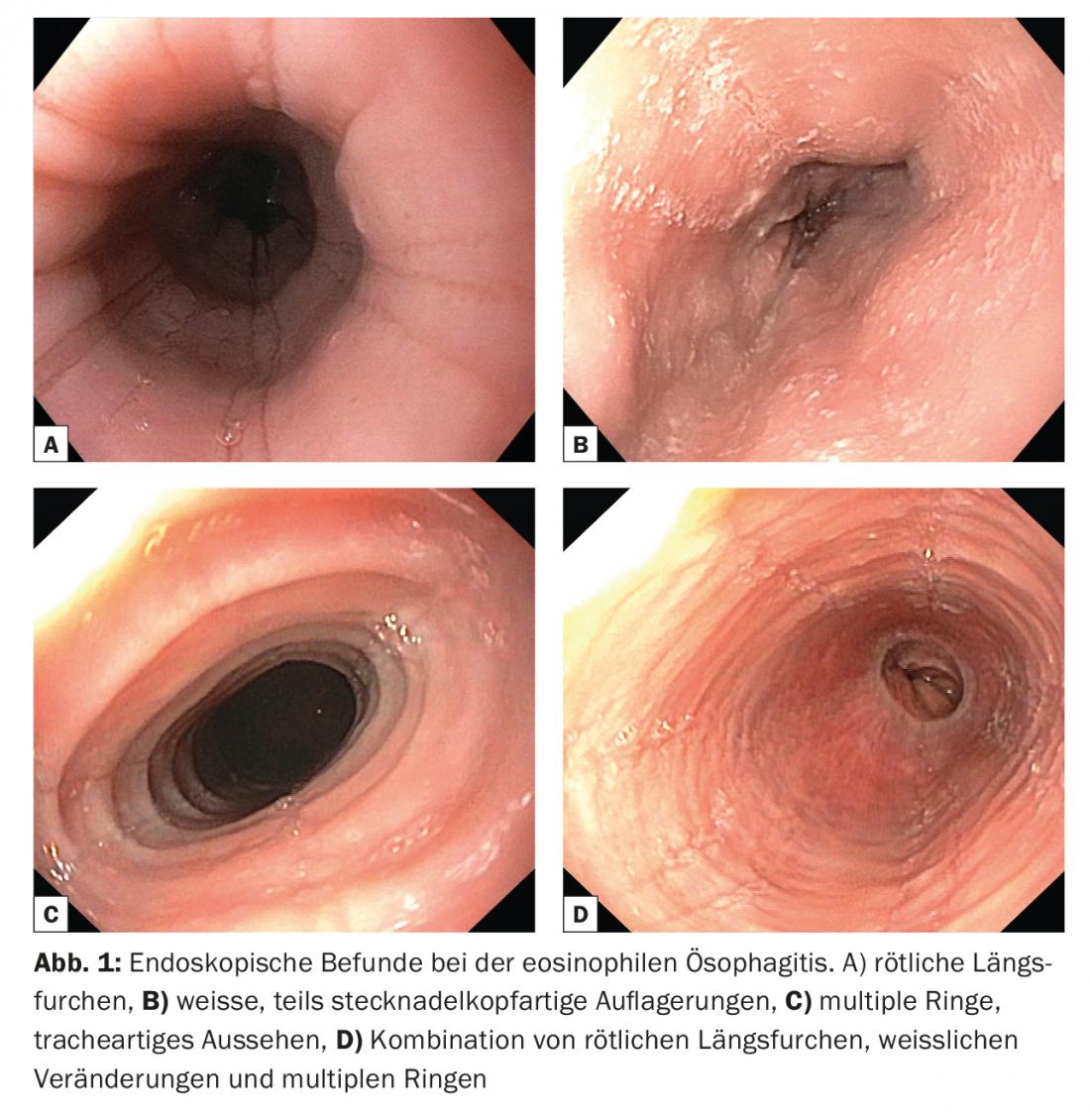
Functional esophageal examinations
Conventional 24-hour pH-metry and esophageal manometry have not shown a disease-specific pattern in EoE and thus are not useful for further characterization of EoE. Combined pH-metry/impedance measurement, on the other hand, can quite reliably differentiate EoE from reflux disease.
Therapy
The therapeutic goal should be “absolute” freedom from symptoms, i.e., food intake without restrictions such as omission of fibrous or dry foods, and without evasive maneuvers such as careful and prolonged chewing or copious drinking. Patients with a well-controlled EoE have a good chance of avoiding one of the unpredictable and not harmless bolus impactions. With successful anti-inflammatory treatment, the dreaded fibrosis of the esophagus, called remodeling, can be prevented.
Therapeutic options
Drug options available include proton pump inhibitors, topical and systemic corticosteroids, conventional immunosuppressants, biologics, leukotriene antagonists, CRTh2 (chemoattractant homologous receptor expressed on Th2 cells) antagonists, and dietary measures and dilation (Table 4) [5,6].
Proton pump inhibitors (PPI)
PPI therapy is usually ineffective for the treatment of EoE. However, to differentiate between reflux and EoE, high-dose PPI therapy (at least two weeks of treatment with double the dose of standard therapy) preceding diagnostic endoscopy may be helpful. In addition, because of the complex relationship between acid reflux and EoE, there are two groups of patients who benefit from PPI treatment. First, these are patients with coexisting reflux disease. Second, a subset of patients with typical EoE symptoms and histologic findings respond to PPI therapy despite excluded reflux. The cause of this phenomenon has not been completely clarified, but it has been shown that PPIs can exert an antieosinophilic effect independently of their acid-suppressing effect by inhibiting the secretion of the messenger substance eotaxin-3. This subgroup of patients with EoE who respond to PPI treatment has been termed “PPI responsive EoE” (PPI-REE) [7].
Topical and systemic corticosteroids
Topical and systemic corticosteroids are very effective in the treatment of EoE in both children and adults [5,6]. They are able to reliably treat both the swallowing difficulties and the eosinophilic inflammation. Their effect has so far been demonstrated in several prospective controlled studies. With the exception of local candidiasis, which usually responds to topical measures, topical steroids have a favorable side effect profile and are therefore currently considered first-line therapy. Fluticasone and budesonide are two inhaled substances with comparable efficacy. The galenic form could be improved, as the active substance should remain in the esophagus as long as possible. A budesonide melt tablet for topical application is currently in advanced clinical trials (phase III study) [8].
If symptoms and inflammation remain refractory despite correct application of topical corticosteroids, a treatment trial with systemic corticosteroids should be primarily attempted, with treatment duration limited to a few weeks because of known steroid side effects.
Immunosuppressants and biologics
There are currently few alternatives for steroid-refractory disease. There is only one promising case report on the established immunosuppressants azathioprine and 6-mercaptopurine, but their effect has not been confirmed by any controlled study. A pilot study with the TNFα-blocker infliximab showed sobering results, although in active EoE the esophageal squamous epithelium massively expresses TNFα. Studies with monoclonal antibodies against IL-5, IgE and against IL-13 are currently being tested in clinical trials. In conclusion, severe and refractory EoE should only be treated at specialized centers within study protocols in order to develop better informed treatment recommendations. Leukotriene antagonists and CRTh2- blockers – a new generation of anti-allergic drugs – currently play a minor role in the treatment of EoE.
Elimination and elemental diets
Children with EoE often suffer from food allergies, so elemental diets and individual elimination diets based on skin testing have been tried in dietary management. Also, the empirical “6-food elimination diet”, based on omission of the critical food groups cow’s milk, soy, eggs, wheat, nuts and seafood, is successfully applied in the treatment of EoE [5,6]. The elemental diet is superior to the other two diets in terms of response rates. Disadvantages of all these forms of diets are their great intrusion into personal daily life and the fact that reintroduction of the triggering food leads to a flare-up of the eosinophilic inflammatory reaction. It is essential to pay attention to nutritional deficiencies in dietary treatments.
In adolescent and adult EoE patients, the circumstances are somewhat more complex, as sensitization to aerogenic allergens is also present. Accordingly, initial trials with individual elimination diets have not shown convincing results and elemental diets are practically not applicable in adults due to massively intrusive changes in diet. An exception is the mentioned “6-food elimination diet”, which has shown a decent effect in adults and can at best be replaced by a somewhat simpler “4-food elimination diet” [9,10]. Again, this shows that re-introduction of the triggering food leads to clinical and histologic relapse.
Dilatation treatment
Endoscopic procedures should be reserved for patients with stenoses and strictures who have not responded or have responded inadequately to prior medical therapy. Although dilatations control symptoms for more than a year on average, they do not affect the progression of the inflammation underlying the stenoses. In addition, dilatations of any kind in EoE are associated with a slightly increased risk of perforation.
Long-term course and prognosis
Based on a long-term observational study, we know that EoE is a chronic inflammatory condition with persistence of symptoms and inflammation over years. The main concern here is fibrosis of the esophagus resulting from eosinophilic inflammation [11]. This should definitely be prevented by early anti-inflammatory therapy. However, whether all patients or only certain at-risk groups are at risk of stricturing courses is still completely unclear.
Literature:
- Furuta GT, et al: Eosinophilic esophagitis in children and adults: a systematic review and consensus recommendations for diagnosis and treatment. Gastroenterology 2007;133: 1342-1363.
- Liacouras CA, et al: Eosinophilic esophagitis: Updated consensus recommendations for children and adults. J Allergy Clin Immunol 2011; 128: 3-20.
- Straumann A, et al: Natural history of primary eosinophilic esophagitis: a follow-up of 30 adult patients for up to 11.5 years. Gastroenterology 2003; 125: 1660-1669.
- Hirano I, et al: Endoscopic assessment of the oesophageal features of eosinophilic oesophagitis: validation of a novel classification and grading system. Gut 2013; 62: 489-495.
- Dellon ES, et al: Advances in clinical management of eosinophilic esophagitis. Gastroenterology 2014; 147: 1238-1254.
- Straumann A: Treatment of eosinophilic esophagitis: diet, drugs, or dilation? Gastroenterology 2012; 142: 1409-1411.
- Molina-Infante J, et al: Proton pump inhibitor-responsive esophageal eosinophilia: an entity challenging current diagnostic criteria for eosinophilic esophagitis. Gut 2016; 65: 524-531.
- Miehlke S, et al: A randomised, double-blind trial comparing budesonide formulations and dosages for short-term treatment of eosinophilic oesophagitis. Gut 2016; 65: 390-399.
- Lucendo AJ, et al: Empiric 6-food elimination diet induced and maintained prolonged remission in patients with adult eosinophilic esophagitis: a prospective study on the food cause of the disease. J Allergy Clin Immunol 2013; 131: 797-804.
- Molina-Infante J, et al: Four-food group elimination diet for adult eosinophilic esophagitis: A prospective multicenter study. J Allergy Clin Immunol 2014; 134: 1093-1099.
- Schoepfer AM, et al: Delay in diagnosis of eosinophilic esophagitis increases risk for stricture formation in a time-dependent manner. Gastroenterology 2013; 145: 1230-1236.
HAUSARZT PRAXIS 2016; 11(12): 12-15

